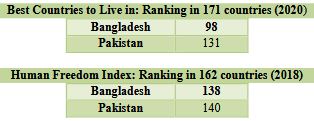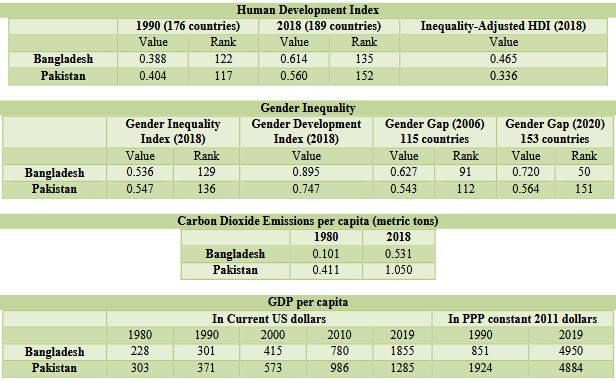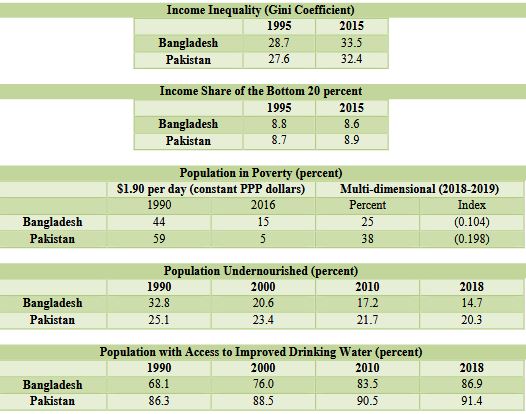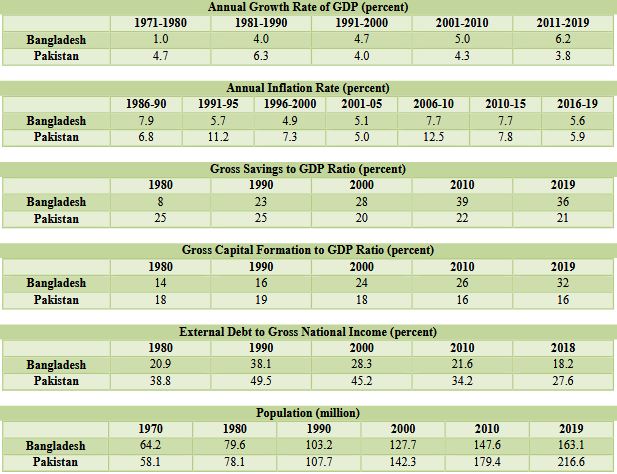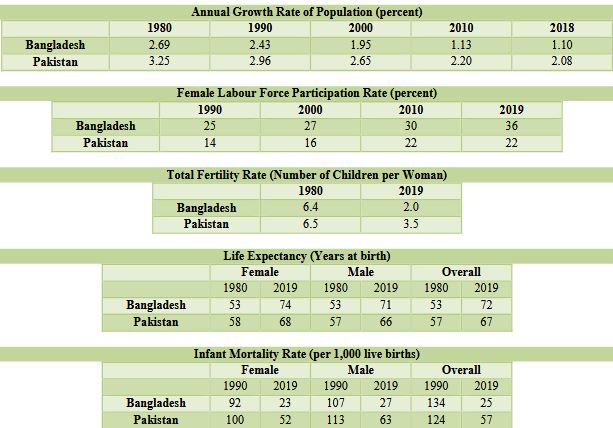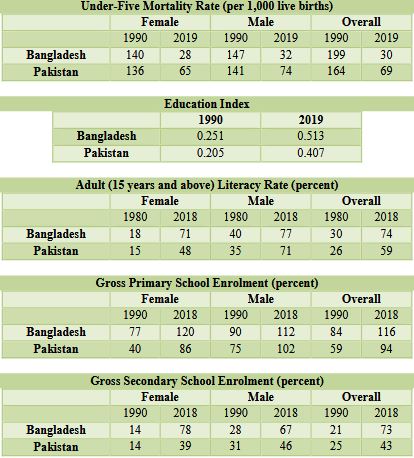Bangladesh And Pakistan: The Great Divergence (PIDE Knowledge Brief No. 16:2020)
Bangladesh and Pakistan: The Great Divergence
Mahmood Hasan Khan, Emeritus Professor of Economics, Simon Fraser University, Canada.
There was a time when Bangladesh lagged behind Pakistan in the quality of life measured by any of its major indicators, except for adult literacy and schooling of children. But it is a different story today. Bangladesh is ahead of Pakistan in almost every respect. I intend to present the facts (data) to support this proposition first and then explore the reasons for the great divergence. I am far more certain about the evidence than I am of my explanation since some of it is guesswork, though hopefully not too off the mark.
We have reasonably reliable data for making comparisons on the levels of and changes in the quality-of-life indicators during the last 30 to 40 years. I use the data cited by the World Bank, UNDP and other international organisations. Well, Bangladesh is a far better country than Pakistan to live in and enjoy more freedoms. (Paradoxically the perception is that Pakistan is less corrupt and an easier place to do business, and its people are happier.) When we look at the Human Development Index (HDI), the position of Bangladesh (135) is higher than of Pakistan (152) in the ranking, though Bangladesh was behind Pakistan 30 years ago. The value of HDI for Bangladesh rose from 0.388 in 1990 to 0.614 in 2018 whereas for Pakistan it went up from 0.404 to 0.560. The HDI values adjusted for inequality differ even more: 0.465 for Bangladesh and 0.336 for Pakistan. An equally important fact is that the gender gap in Bangladesh is much smaller than in Pakistan and women in Bangladesh have made far more progress.
These changes are well supported by some of the other indicators. The average income per capita (measured in current US dollars) is one-third higher in Bangladesh now whereas it was lower by one-third in 1980. If measured in the constant PPP dollars, the income level in Bangladesh rose by six times from $851 in 1990 and by only 2.5 times from $1924 in Pakistan. The difference is striking. The growth of income in Bangladesh has also been much less detrimental to the environment: CO2 emissions per capita were one-half of those in Pakistan. In both countries income inequality is reasonably low, though it has increased somewhat; there has been little change in the income share of the bottom 20 percent of the households. My guess is that wealth is more concentrated in Pakistan than in Bangladesh because of the differences in land concentration.
Looking at poverty, there are at least three measures of it: the national poverty lines that are incomparable; the international poverty line based on per capita expenditure of PPP$1.90 per day; and the multi-dimensional poverty index developed recently. Pakistan’s performance in poverty reduction, measured by the international poverty line, has been far more impressive than of Bangladesh. However, using the multi-dimensional measure of poverty, Bangladesh has a far better position: only one-quarter of its population is poor compared with about 40 percent in Pakistan. The incidence of undernourishment is also significantly lower in Bangladesh and it has gone down more impressively than in Pakistan. While a slightly higher proportion of population in Pakistanis has access to good drinking water, Bangladesh has made far more progress in making this access possible in the last 30 years. A similar trend can be noted for people’s access to improved sanitation.
The differences in the growth of GDP and population in the two countries can well explain the achievements in the level of per capita income. In the last fifty years, the annual growth rate of GDP in Bangladesh went up in every decade from 1.0 percent in the 1970s to 6.2 percent in this decade; in Pakistan the rate went up from 4.7 percent in the 1970s to 6.3 percent in the 1980s, but has fallen to 3.8 percent in this decade. (In the last thirty years, economic growth in Bangladesh occurred with lower inflation than in Pakistan.) The proximate reason for the growth differential can be seen in the level of savings and investment in the two countries. The level of savings relative to GDP in Bangladesh increased from merely 8 percent in 1980 consistently to 36 percent in 2019. In Pakistan, the level of savings fell over time from 25 to 21 percent. For investment, in Bangladesh the level rose from 14 percent in 1980 to 32 percent in 2019, but in Pakistan it fell from 18 percent to 16 percent in the same period. Bengalis have been saving and investing more of their income compared to Pakistanis who have also borrowed more from abroad if we look at the foreign debt to GDP ratios for the two countries.
Perhaps a more interesting fact is that the rate of growth of population in Bangladesh declined consistently from 2.69 percent in 1980 to 1.1 percent in 2018. In Pakistan, the rate was higher in 1980 (3.25 percent) and fell more slowly to 2.1 percent in 2018. Consequently population in Pakistan almost tripled to 217 million in 2019 and only doubled in Bangladesh to 163 million. The total fertility rate in Bangladesh went down from 6.4 children per woman in 1980 to 2 children in 2019. Compare it with Pakistan where there were almost the same number of children per woman in 1980, but almost twice as many (3.5 children) in 2019. This difference between the two countries is a reflection of the success of family planning in Bangladesh.
In Bangladesh, both females and males are living longer to 74 and 71 years, respectively, compared with 68 and 66 in years in Pakistan, although that was not the case in 1980 when the average life-span was longer in Pakistan. This difference is reflected in the changes in the infant and under-five mortality rates. We notice two important markers. First, in 1980 the overall mortality rate for infants and under-five children was higher in Bangladesh, but there has been a huge decline: from 134 (per 1,000 live births) to 25 for infants and from 199 to 30 for the under-five children compared with Pakistan where the rates went down from 124 to 57 and from 164 to 69, respectively. Second, similar differences can be seen in the mortality rates for the female and male infants and under-five children since 1990. The levels in Bangladesh are strikingly lower now compared to the mortality rates in Pakistan. It is obvious that the demographic revolution in Bangladesh has led to fewer births and longer life for the children after birth.
Bangladesh has done even better in human capital formation. It had an edge over Pakistan even in the 1980s. Looking at the values of the Education Index for the two countries, in Bangladesh it rose from 0.251 in 1990 to 0.513 in 2019 and in Pakistan from 0.205 to 0.407 in the same period. Bangladesh has made impressive achievements in adult literacy and school enrolments of both females and males. It was slightly ahead of Pakistan in adult literacy in 1980, but since then the gap has widened: nearly three-quarters of adults in Bangladesh were literate in 2018 compared with about 60 percent in Pakistan. The gap is wider for females: 71 percent versus 48 percent. A similar change can be seen in school enrolments, especially of females. At the primary level, in Bangladesh the proportion in school went up from 84 percent in 1980 to 116 percent in 2018, whereas in Pakistan it rose from 59 to 94 percent. In the secondary schools, Bangladesh has done equally well: the enrolment rate increased from 21 percent in 1980 to 73 percent in 2018; in Pakistan the rate went up from 25 to 43 percent. A more notable fact is that the female enrolment rate in secondary schools was similar (14 percent) in the two countries in 1990, but now it is 78 percent in Bangladesh and 39 percent in Pakistan. Females in Pakistan have obviously lagged behind quite markedly.
The evidence is reasonably clear that Bangladesh has marched ahead of Pakistan in the last 30-40 years after starting from a lower position in 1971. Needless to add, its people suffered grossly from a monstrous cyclone—500,000 people were killed—in 1970 and by the brutal civil war in 1971. On its position before independence from Pakistan, I should refer to the 1970 report of a panel of economists from East Pakistan for the Fourth Five-Year Plan. They argued that much of the backwardness of East Pakistan and the inter-wing disparity were due to the systemic institutional and policy biases. Some of their evidence and arguments were contested by economists from West Pakistan. But much of the evidence was on the side of the East Pakistani economists. Life in East Pakistan was not as good as in West Pakistan for reasons that had to do primarily with the nature of the Pakistani state and the structure of power relations. It is fair to say that it was resentment on one side and insensitivity on the other that led to the break-up of Pakistan. I will say no more since much has been written about this sad chapter of recent history.
How can we explain the great divergence? I will try to make guesses here. I am sure that others, better informed and educated, can provide us with more coherent and convincing account. My first guess is that independence from Pakistan allowed the people of Bangladesh the opportunity to remake the political and administrative structure that had treated East Pakistan as a colony of Pakistan from 1947 to 1971. They could now build institutions and direct resources to meet their national goals. Gaining autonomy for decisions and actions was only the first step to lay the foundation of a new economy and society. But that wouldn’t be enough to explain the changes I have highlighted. I should emphasise that in any comparison between the two countries, we should not underestimate the disruptive role of natural calamities. In the last fifty years, floods and cyclones have been far more frequent and severe with devastating effects on the economy and society of Bangladesh. The cyclones of 1970 and 1991 killed about 650,000 people. In Pakistan, floods and earthquakes have been far less frequent and their effects not as severe. People and settlements in Bangladesh are evidently more vulnerable to the vagaries of Nature than they are in Pakistan.
My view is that the interdependent forces of culture, institutions and policies have played a major role in the divergence between Bangladesh and Pakistan. The society in Bangladesh is culturally far more homogeneous than in Pakistan: look at language, ethnicity, religion, customs, food, and much else. Besides, it is also less divided by caste and class and its social structure is less hierarchical in both the home and outside. Related to this is the fact than women in Bangladesh are far less secluded than in Pakistan: they have enjoyed a better status at home and in the community. One has to look at their participation in the economy and society, e.g. more than one-third of them work in the labour force compared with less than one-quarter in Pakistan. A more open and secular milieu supported by the state and civil society institutions may have been important for women’s empowerment in Bangladesh. You don’t see the same development in Pakistan. Furthermore, the agrarian reforms of 1951 had reduced the inequalities in landownership and rural life in East Pakistan. They had disempowered the land-based oligarchy. No such changes have been allowed to occur in Pakistan. If anything the landed elite have formed strategic alliances with other powerful groups to maintain their influence in society.
Bangladesh went through a tumultuous period of nearly 20 years, starting from the civil war followed by political instability, including the army rule (1975-1981 and 1982-1990). Mercifully, the army’s involvement in politics ended in 1990. Since then it has stayed in the barracks, though there have been some aborted mutinies and coup attempts. The elected governments, though by no means clean or democratic, have however given reasonable stability and the rule of law to the country in the last thirty years. Besides Bangladesh has had very little mass violence or acts of terrorism inside the country and no involvement outside its borders. In Pakistan, the army has ruled the country under one pretext or another for long spells since the late 1950s (1958-1970, 1977-1988 and 1999-2008). And in the last 12 years, it has
been the kingmaker and powerbroker. Nor is this all. Its active involvement in the affairs of Afghanistan and Kashmir has had serious consequences on life inside the country. Pakistan has almost five times more army personnel than Bangladesh and it also spends a much larger proportion of its GDP on the army. Equally importantly, the army in Pakistan plays a more active role in the economy through ownership of real estate and industries and by contractual services.
In Bangladesh, the civil society institutions, particularly NGOs (like the Grameen Bank and BRAC), have played an important role in supporting the efforts of the government to promote the interests of the poor, females in particular, through various policies and instruments, e.g. access to small loans, health care, schooling, family planning, skills training and so on. Besides, Bangladesh has received much external assistance for these activities and it has utilised it more efficiently than has Pakistan. The partnership of government with NGOs and the donors has been consistently more harmonious than in Pakistan. No matter what the shade of its government, Bangladesh has pursued pragmatic economic policies and promoted diversification of the economy. (The development of the garment industry with foreign capital and female workers has no parallel in Pakistan.) Its human capital has also been a source of increased productivity in the economy. Not so in Pakistan: it has depended more on physical capital.
The state in Pakistan has been more audacious as well with unhappy consequences. The pseudo-socialist experiment of the 1970s bloated the size of the public sector, greatly weakened the role of the private sector and distorted the signals for economic activity. The authoritarian populism of that period did not improve the life of ordinary people. This audacious experiment was followed by a pseud-Islamic experiment that has pushed the country towards religious intolerance, bigotry and division of society. At the same time, Pakistan, induced by the United States, plunged into the on-going civil war in Afghanistan. Consequently, Afghan refugees and the Taliban-turned-terrorists—in whose growth Pakistan had played a major role—took a high toll on civic peace, life and resources. Resources that should have gone to make the economy stronger and improve the quality of life of ordinary people were used to secure internal and external security. Violence and religious extremism have become part of the social fabric. Bangladesh didn’t have to carry this extra baggage. The relatively high growth rate of GDP in Pakistan during the periods of the army rule (1977-1988 and 1999-2008) was due mainly to the inflow of foreign aid and the internationally-sponsored macroeconomic stabilisation programmes and some minor reforms.
I should also emphasise the difference between the two countries in their national priorities and strategies. In Bangladesh, a high priority was given to the development of social and human capital. This was not the case in Pakistan: physical infrastructure, national defense and internal security were considered more important. Bangladesh put more national resources and foreign assistance than did Pakistan to develop human capital (education and health care). In addition, the state institutions in Pakistan were more intrusive in the economy than in Bangladesh if you compare the size of the public sector, including the armed forces, and government policies on regulating the domestic markets, foreign trade, and the flow of foreign private capital for investment. Pakistan looks more like a war economy and Bangladesh more like a peace economy.
A final point with which I should end this note. In Pakistan, unlike Bangladesh, land, religion and army have occupied a central place in the public sphere with their corrosive effects on the well-being of ordinary people. This difference between the two countries is an important part of the explanation of the observed divergence.
APPENDIX



